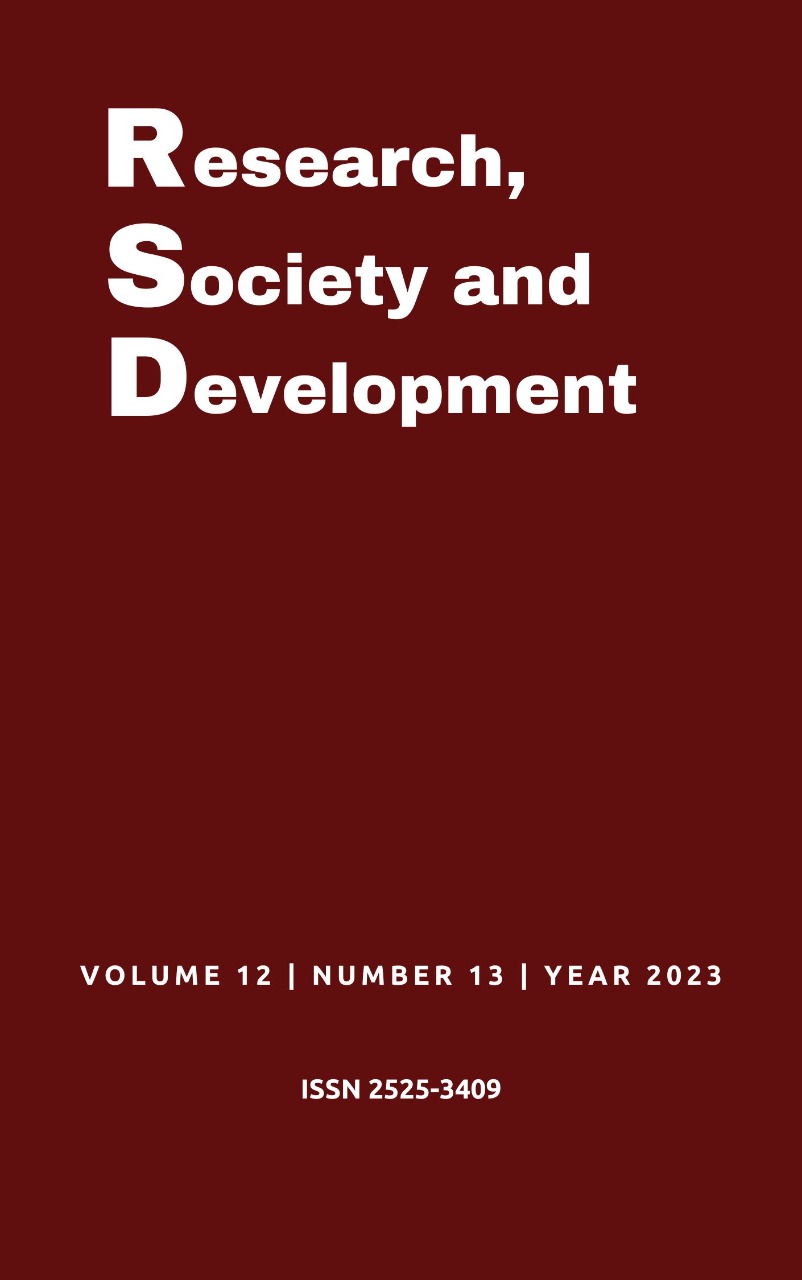The use of invisible aligners by dentists in the city of Manaus/Amazonas
DOI:
https://doi.org/10.33448/rsd-v12i13.44131Keywords:
Orthodontic treatment, Oral cavity, Aesthetics, Dental surgeons.Abstract
Introduction: The orthodontic procedure with invisible aligners has gained important notoriety in current times, especially among patients seeking effective treatment combined with the oral cavity. Given the constant search for more discreet or “invisible” orthodontics, the development of devices that meet these expectations has become increasingly frequent. Objective: aims to identify dental surgeons, orthodontists and general practitioners who use invisible aligners and the acceptance of this orthodontic treatment alternative by professionals, as well as by patients in the city of Manaus/AM. Methodology: This is a statistical, quantitative and cross-sectional study, developed with dental surgeons and orthodontists in the city of Manaus/ AM., using data collected through a questionnaire. The results highlight the advantages of therapy with clear aligners, such as pleasant aesthetics, better oral hygiene, ease of removal, comfort and their applicability in a variety of cases, in addition to discreet attachments and specific benefits for certain tooth movements. Final considerations: Therefore, obtaining representative statistical data on their application is extremely relevant, providing a solid scientific basis for understanding the reality of the use of these devices in the region.
References
Borges, G. S. de B., & Santos, J. B. (2022). Tratamento ortodôntico em paciente adulto para recuperação de espaço perdido pós exodontia: relato de caso. Research, Society and Development, 11(7), e53611730443. https://doi.org/10.33448/rsd-v11i7.30443.
Compass3d. (2020). Alinhador transparente sem complicação. Compass3d, 2020. https://compass3d.com.br/orthoaligner/.
Cançado, R. H., Demenech, J., Neves, L.S., Valarelli, F. P., & Freitas, K. M. S. (2016). Tratamento da classe III assimétrica. Orthodontic Science and Practice. 9(35): 154-61.
Cordeiro, M., & Zago, H. (2019). Alinhador ortodôntico (invisalign®): uma realidade. Revisão de literatura. Revista gestão & saúde. 21(2): 47-53. Issn 1984 – 8153.
Estrela, C. (2018). Metodologia Científica: Ciência, Ensino, Pesquisa. Editora Artes Médicas.
Greppe, F. V., & Sigilião, L. C. F. (2017). Sistema invisalign®: uma revisão de literatura. Revista Naval de Odontologia. 44(1): 43-7.
Lakatos, E. M., & Marconi, M. A. (2021). Fundamentos de metodologia científica. (9a ed.), Editora Atlas.
Lopes, M.B., Rocha C.A.H., Leal, H.S.R. (2019). Alinhadores ortodônticos estéticos: uma revisão de literatura. 10º seminário de iniciação científica/ 1º seminário de pesquisa e pós-graduação stricto sensu, Issn 2237 - 8901.
Maciel, J. A.C., Monteiro, A. K. A., Pará, J. W. S., Sousa, J. R. & Castro-Silva, I. I. C. (2022). Com dor de dente, tudo é ruim nesta vida! saúde bucal na comunidade indígena de Tremembé, Ceará, Brasil. Interface, 26, 1-17.
Maciel, G. de M.., Verde, G. L., Rêgo, M. R. de S., & Monte, T. L. (2023). O impacto do tratamento ortodôntico na qualidade de vida dos pacientes com má oclusão. Research, Society and Development, 12(7), e0912742421. https://doi.org/10.33448/rsd-v12i7.42421.
Malik, O. H., McMullin, A., & Waring, D. T. (2013). Invisible orthodontics part 1: invisalign. Dental Update. 40(3), 203–215.
Marya, A., et al. (2020). Essential Attributes of Clear Aligner Therapy in terms of Appliance Configuration, Hygiene, and Pain Levels during the Pandemic: A Brief Review. Hindawi, Pain Research and Management. Article ID 6677929,6 pages; https://doi.org/10.1155/2020/6677929.
Merchán-Haman, E., & Tauil, P. L. (2021). Proposta de classificação dos diferentes tipos de estudos epidemiológicos descritivos. Epidemiol. Serv. Saúde, 30 (1). 10.1590/s1679-49742021000100026.
Monteiro, M.P.M. (2015). Sistema invisalign® aplicações em ortodontia. Mestrado integrado em Medicina Dentária. Porto – Portugal: Universidade Fernando Pessoa, 2015. https://bdigital.ufp.pt/bitstream/10284/5090/1/PPG_7795.pdf.
Nedwed, V., Miethke, R. R. (2005). Motivation, acceptance and problems of invisalign patients. Journal of Orofacial Orthopedics. 66(2): 162-73.
Ozelame, A. P., Seco, F., Mioso, F. V. (2018). Reabilitação oral após o uso de prótese total imediata: relato de caso clínico. 39(1): 15-20.
Pereira, A. S. Shitsuka, D. M., Parreira, F. J., & Shitsuka, R. (2018). Metodologia da pesquisa científica. UFSM. https://repositorio.ufsm.br/bitstream/handle/1/15824/Lic¬-Computacao-Metodologia-Pesquisa-Cientifica.pdf.
Rodrigues, F. A. D., Costa, T. S. (2018). Estética Em Ortodontia: Tratamentos Alternativos. Mestrado Integrado em Medicina Dentária. Lisboa – Portugal: Instituto Universitário Egas Moniz. http://hdl.handle.net/10400.26/25555.pdf.
Silva, J. P. P., Carneiro G. K. M., Stirma M., & Moretto M. J. Ortodontia invisível - uma alternativa estética. Revista Saúde Multidisciplinar. Mineiros – GO; 2017; 32(4): 175-190.
Sousa, H. A. de F., Nascimento, J. J. P. N. F. do., Sousa, M. A. de F., Genari, B., Souza, A. O., & Degrazia, F. W. (2021). Aparelhos ortodônticos invisíveis: uma revisão. Research, Society and Development, 10(1), e5510111259. https://doi.org/10.33448/rsd-v10i1.11259.
Teodoro, L., Santos, E. O., Câmara, J. VF, Claudino, D. L., Campos, P. R.B., & Barbosa, I. F., et al. (2023). Reabilitação estética com facetas pré-fabricadas de resina composta: relato de caso. Investigação, Sociedade e Desenvolvimento.; 9(8):1-15.
Thukral, R., & Gupta, A. (2015). Invisalign: Invisible Orthodontic Treatment-a Review. Journal of Advanced Medical and Dental Sciences Research, 3(5): 42–44.
Urzal, V., Ferreira, A. P., & Ferreira, A. P. (2010). Análise do sistema Invisalign no que concerne às vantagens e limitações. Revista de Ortodontia. 13:28-39.
Vale, L. S. V. (2018). Alinhadores invisíveis: uma alternativa ortodôntica estética. Mestrado integrado em Medicina Dentária. Porto - Portugal: Instituto Universitário Egas Moniz. https://comum.rcaap.pt/handle/10400.26/23509.pdf.
Downloads
Published
Issue
Section
License
Copyright (c) 2023 Ricardo Jordão de Souza; Paulo Henrique Gomes Prates; Evandro da Silva Bronzi

This work is licensed under a Creative Commons Attribution 4.0 International License.
Authors who publish with this journal agree to the following terms:
1) Authors retain copyright and grant the journal right of first publication with the work simultaneously licensed under a Creative Commons Attribution License that allows others to share the work with an acknowledgement of the work's authorship and initial publication in this journal.
2) Authors are able to enter into separate, additional contractual arrangements for the non-exclusive distribution of the journal's published version of the work (e.g., post it to an institutional repository or publish it in a book), with an acknowledgement of its initial publication in this journal.
3) Authors are permitted and encouraged to post their work online (e.g., in institutional repositories or on their website) prior to and during the submission process, as it can lead to productive exchanges, as well as earlier and greater citation of published work.


